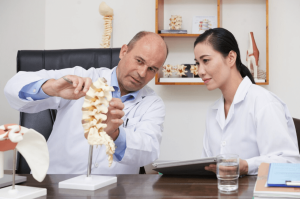Back, neck and shoulder pain caused by sitting at a desk is an incredibly common cause of stress and fatigue among working Americans. If you work in an office and spend your day sitting on a chair behind a desk, then you absolutely know how it feels!
Going home every day feeling exhausted and drained can be a familiar dilemma. Your job might not require you to lift heavy objects but sitting in a static position with an incorrect posture can tire you out just the same – not to mention the damage it can cause to your spinal structure.
But much of that discomfort caused by prolonged sitting with poor posture can be avoided. All we have to do is understand how to sit in an office chair to avoid back pain, identify problem areas, and make simple adjustments to adopt proper posture.
The Problem: What Sitting Incorrectly Does to Your Spine
Slouching forward and down is one of the most common tendencies during sitting – especially during long desk hours. This position overstretches spinal ligaments and compresses discs, contributing to lower back pain and fatigue.
Poor sitting posture places unnatural stress on the spine and leads to compensation patterns in your muscles. Over time, static positions lead to muscular imbalance, reduced mobility, and chronic tension.
Research has shown that prolonged sedentary behavior and poor sitting habits are strongly associated with musculoskeletal issues, including neck pain, spinal stiffness, and postural strain. In contrast, maintaining proper sitting posture with supportive ergonomics can help prevent these problems over time.
(Also check out our post on the basics of workplace ergonomics. Lots of great tips from McHenry Chiropractor Dr. Casey in that one.)
The Solution: Practice the Proper Sitting Posture
There’s actually a lot that goes into sitting properly. Dr. Casey lays out some great tips in this video (click here) and we cover more below.
The issue is that it’s hard to have great sitting posture if your chair isn’t supporting you correctly. And that’s what the tips below go into.
Once you get familiar with the proper sitting posture and learn how to use your chair properly, you will have the awareness to correct yourself when you slouch. With enough practice, you can definitely make it your new normal.
Ideally, correct posture at a desk includes a slight recline of 100–110°, with hips positioned far back in the seat. Your spine should maintain its natural curves, especially at the lumbar region, aided by built-in lumbar support.
Your feet should remain flat on the floor, knees level with or slightly below your hips. Align your ears, shoulders, and hips in a vertical plane. An ergonomic office chair can help you hold this neutral posture, reducing strain.
4 Chair Adjustments to Customize for Comfort
#1 Maintain a comfortable distance:
Much of the tension on your back is caused by overreaching towards your desk, keyboard and mouse. A simple solution to is to get a little closer and maintain the right distance. If you are using a rolling chair, make sure to stay in place so as to be comfortably close to your desk.
#2 Ensure proper arm support:
The armrest of your chair plays an important role in keeping a proper sitting posture. Your elbows should be at a slightly more than 90-degree angle. Again, avoid overreaching.
Observe that when you slouch, you are putting much of your weight on your back instead of having your arms as support. If you have a chair with adjustable armrests, play with them until you get the proper alignment. Customize depending on your height and comfort.
#3 Adjust the height of the chair:
Your knees should be roughly at the same height or a little bit lower than your hips. Most office chairs have a way to adjust the height so play around until you find a height that it comfortable for both your knees and forearms.
#4 Get the right lumbar support:
Many office chairs have some sort of built in lumbar support and you’ll want to make use of it.
Lumbar refers to the lower back. Desk chair ergonomics will have the ears, shoulders and hips aligned so as to relieve pressure and weight from the lumbar portion. Recline the back of the chair to about 100 to 110 degrees. Keep your hips far back in the chair so your lumbar can be fully supported. You want to maintain the three normal curves of the spine.
When your lumbar support is too high, it makes you lean forward and slouch – causing you to feel fatigued. When it’s too low, it forces you to hyper-extend your back – resulting to back pain. Position the adjustable lumbar support just above the belt line. The goal is to keep the natural curvature of the spine.
If your chair doesn’t have a built-in lumbar support, a nice trick is to use a thick throw pillow instead.

4 Desk Etiquette Tips to Reduce Sitting Strain
#1 Don’t skip your daily stretching.
You are in a static sitting position so much daily. Show your muscles some love by stretching them out before starting a long day at work. Also, try to get in a quick stretching session every 30-60 minutes while at your desk – even if you just stand up and touch your toes a couple times or do a gentle back bend. This also helps blood to circulate better. Set a timer if needed. A few seconds of stretching or a quick walk boosts circulation and eases tight muscles.
#2 Avoid crossing your legs.
Crossing your legs puts a lot of pressure on your pelvis and lower back. Over time, it may cause chronic pain or ongoing issues. Avoid this by keeping your feet flat on the floor.
#3 Never cradle the phone.
You may have unconsciously formed the habit of cradling the phone between your shoulders and ears. This strains your upper back and neck. As an alternative, use a hands-free headset.
#4 Pay attention to your breathing.
Breathing from your belly (also called diaphragmatic breathing) relieves the whole body from pressure. Relax your upper body by drawing your navel towards your spine each time you inhale. (You can learn more about diaphragmatic breathing here)
Example Stretch Schedule:
- 9:30 AM – neck rolls
- 11:00 AM – seated spinal twist
- 1:00 PM – standing quad stretch
- 2:30 PM – backbend or chest opener
- 4:00 PM – heel-toe raises at your desk
Daily Movement Strategies for Desk Workers
Even with an ergonomic chair and comfy seat cushion, you need to move. It’s recommended to get up every 30 minutes for a quick stretch or lap around your workspace. You should also shift your sitting position often to avoid stiffness.
Try to integrate movement creatively – try walking meetings, take calls while standing, or set up a standing desk to alternate work positions. Simple movements like heel-toe raises or light mobility drills help maintain healthy spinal function.
Creating an Ergonomic Workspace
Your workspace setup matters just as much as the office chair you sit in. A few smart tweaks can go a long way in promoting good posture and keeping discomfort at bay.
- Monitor: Position it at eye level and about an arm’s length away so you’re not constantly looking up or down.
- Keyboard & Mouse: Keep them close enough so your elbows stay relaxed at your sides and your wrists stay straight.
- Document Stand: If you’re referencing papers often, a stand helps avoid all that neck craning.
- Footrest or Floor Mat: If your feet don’t touch the floor comfortably, a footrest gives your legs the support they need – bonus points for using a floor mat to ease pressure during long days.
Adding ergonomic office chairs and a few well-chosen accessories can make your desk a place that supports your body as well as your productivity.
When to Seek Professional Help
There are enough things to stress about at work and life in general. Let’s not make your sitting posture one of them!
By simply following the tips in this article, you will start feeling more relaxed as your work and more energized when it’s time to leave the office.
If you’ve implemented these strategies and still experience pain, numbness, tingling, or reduced mobility, it’s time to seek professional help. These may be signs of an underlying spinal imbalance or repetitive strain.
A chiropractic assessment can uncover alignment issues caused by prolonged sitting and offer corrective treatment. At Evolve Chiropractic, we specialize in ergonomic chair setup, proper sitting posture, and spinal adjustment to help desk workers recover faster and move better. From finding the best office chair to building smarter habits, we’re here to support your spinal health journey.





